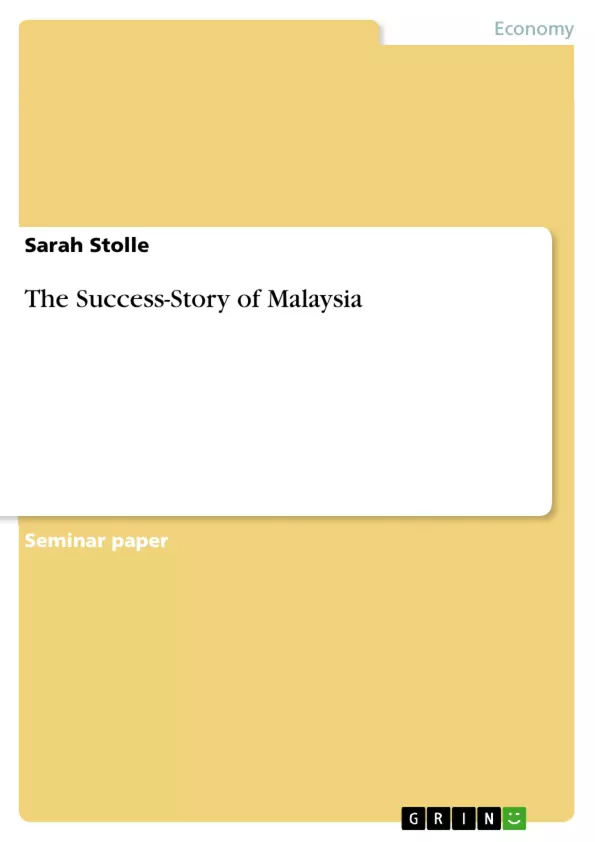Malaysia has been a trade centre for centuries. In the premodern history traded goods were in particular spices, tin and rubber. But the long-term colonial rule and the occupation of the Japanese in World War II didn’t let the economy rise. On the contrary the economy was in a disasterous situation.
But Today Malaysia can be regarded as one of the most successful asian countries which achieved a really effective transition into a modern economy. The most important reason for this change were the consequent policies of the Malaysian government since the 1970s. It was able to integrate the ethnic outsider, the Malay, into the society and economy. Through its development programs it was possible to get rid of the high poverty rate, to built up much more equality in the society and create a well working economy with annual growth rates. Malaysia became a export nation which traded in the last decades mostly textile or rubber products. But in nower days Malaysia also has got a high share of exports in the electronic and high tech branche. Government policy has generally accorded a central role to foreign capital, while at the same time working towards more substantial participation for domestic, especiallybumiputera,capital and enterprise. The current plan “Vision 2020” aims to reach a fully developed industrialized economy in 2020. The first point in the essay is a short background information about the country Malaysia. I continue with the economic history from the premodern history up to the era after the Second World War. The third chapter dicusses the policies of the government; the policies of the transition as well as the contemporary policies. Finally the essay points out the present economic system and why it is so successful.
Inhaltsverzeichnis (Table of Contents)
- Introduction
- Economy of Malaysia
- The Country
- History
- The Premodern Economy
- The Time after World War II
- The New Economic Policy
- National Development Policies from 1970-2000
- Reducing Poverty
- Economic Growth
- Contemporary Policies
- Malaysia Today
- Economic Power and Growth
- Business Enviroment
- Supportive Government Policies
- High Education
- Infrastructure
- Summary
- Bibliography
Zielsetzung und Themenschwerpunkte (Objectives and Key Themes)
This essay aims to provide a comprehensive analysis of Malaysia's economic success story, highlighting the key factors that have contributed to its transformation from a pre-modern economy to a thriving modern one. The essay explores the historical context, including the impact of colonial rule and post-war reconstruction, and focuses on the role of government policies in driving economic growth and social development. It examines the country's economic history, focusing on the transition period and contemporary policies, and outlines the current economic system and its key strengths.
- The impact of historical factors, including colonialism and World War II, on the Malaysian economy.
- The role of government policies in achieving economic development and social transformation in Malaysia.
- The key elements of Malaysia's contemporary economic system, including its strengths and challenges.
- The significance of foreign capital, domestic enterprise, and government support in driving Malaysia's economic success.
- The evolution of Malaysia's export sector, from primary products to high-tech industries.
Zusammenfassung der Kapitel (Chapter Summaries)
The essay begins by introducing Malaysia as a historical trade center, highlighting its reliance on spices, tin, and rubber. It then explores the country's economic struggles under colonial rule and the challenges it faced during World War II. The essay then delves into the historical background of Malaysia, discussing its premodern economy, characterized by limited industrialization and a reliance on primary products. The chapter also analyzes the country's experience after World War II, focusing on the reconstruction efforts and the growing desire for independence. The essay further examines the political landscape of the post-war period, highlighting the challenges posed by fragmentation and the limited success of early development programs.
The essay then focuses on the "New Economic Policy" implemented by the Malaysian government, outlining its goals of reducing poverty and fostering economic growth. It explores the specific policies employed during this period, including strategies to integrate the Malay population into the economy and society.
Schlüsselwörter (Keywords)
The key themes of this essay are focused on the economic history and development of Malaysia, exploring the transition from a pre-modern economy to a modern, industrialized nation. The essay emphasizes the role of government policies, foreign capital, and domestic enterprise in driving this transformation. Key terms and concepts include colonial rule, World War II, the New Economic Policy, economic growth, poverty reduction, export-oriented industries, high-tech industries, and the “Vision 2020” plan.
- Quote paper
- Sarah Stolle (Author), 2006, The Success-Story of Malaysia, Munich, GRIN Verlag, https://www.grin.com/document/60559



